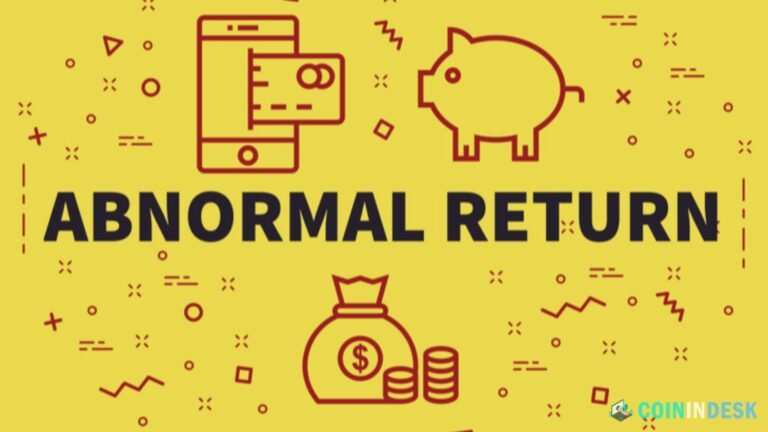This is called an abnormal return when an investment’s actual return is lower than its predicted return, given its risk and current market conditions. In finance, abnormal returns are a metric for evaluating the success of a portfolio or investment. Depending on whether the investment did better than predicted or worse than the market, abnormal returns can be either positive or negative.
Defining Abnormal Return
Abnormal return is calculated by comparing the actual return of an asset to its expected return, typically derived from a financial model such as the Capital Asset Pricing Model (CAPM) or a benchmark index like the S&P 500. The formula for abnormal return is:
Where:
- Actual Return is the real gain or loss experienced by the security or portfolio over a given period.
- Expected Return is the return a financial model predicts, considering the asset’s risk and the benchmark’s return.
Importance of Abnormal Return
Understanding abnormal returns is vital for several reasons:
Performance Evaluation
Investors use abnormal returns to assess whether an investment has performed better or worse than expected, given its risk profile. A positive abnormal return indicates that the investment has outperformed expectations, while a negative abnormal return suggests underperformance.
Market Efficiency
The concept of abnormal return is closely tied to the Efficient Market Hypothesis (EMH). According to EMH, it is impossible to consistently achieve abnormal returns through stock selection or market timing because all available information is already reflected in asset prices. Therefore, observing abnormal returns challenges the validity of EMH and suggests the presence of market inefficiencies.
Investment Strategies
Fund managers and investors seek to achieve abnormal returns through various strategies, such as active management, technical analysis, and exploiting market anomalies. Identifying and understanding the sources of abnormal returns can help refine these strategies and enhance portfolio performance.
Calculating Abnormal Return
To illustrate the calculation of abnormal return, let’s consider an example. Suppose an investor holds a stock that generated a 12% return over the past year. The expected return, based on the CAPM, is 8%. The abnormal return would be:
This 4% represents the stock’s excess return beyond what the CAPM predicted, indicating an outperforming investment.
Models for Calculating Expected Return
Several models can be used to estimate the expected return of an asset, each with its strengths and limitations:
Capital Asset Pricing Model (CAPM)
The CAPM is one of the most widely used models for calculating expected returns. It is based on the relationship between the risk of an asset and its expected return. The CAPM formula is:
Where:
- It is the risk-free rate, typically the yield on government bonds.
- β is the measure of the asset’s sensitivity to market movements.
- Rm is the expected return of the market.
Fama-French Three-Factor Model
The Fama-French model extends the CAPM by adding two additional factors: size and value. The formula is:
Expected Return=Rf+β(Rm−Rf)+s⋅SMB+h⋅HML
Where:
- SMB (Small Minus Big) represents the additional return expected from small-cap stocks over large-cap stocks.
- HML (High Minus Low) represents the additional return expected from value stocks over growth stocks.
Uses of Abnormal Return
When analyzing investments and financial matters, abnormal return is an invaluable instrument. Many significant applications rely on it:
Evaluating Investment Performance
Using abnormal returns, investors can gauge how their investments are compared to the market or their anticipated return. By comparing the two sets of numbers, investors can tell if their assets are producing abnormally high or low returns.
Assessing Portfolio Managers
Additionally, portfolio managers’ performance can be assessed using abnormal returns. Comparing abnormal results can help investors find investment managers or portfolios that routinely beat or miss their expected return. This data can be vital when choosing a portfolio manager or investing.
Event Studies
When looking at how certain occurrences affect the value of investments, event studies frequently employ abnormal returns. Researchers can determine if an incident significantly affected an investment’s performance by calculating abnormal returns around the event’s time. This data can help show how the market responds to certain announcements, including mergers or acquisitions, earnings reports, or regulation changes.
Limitations of Abnormal Return
Although abnormal return is a valuable measure, it does have certain drawbacks, including the following:
Market Efficiency
The premise of abnormal return is that stock prices accurately reflect all important information and that markets are efficient. Anomalies in returns could not indicate an investment’s true performance if market efficiency is lacking.
Risk Factors
Risk models are commonly used to determine the expected return in abnormal return calculations. An incorrect expected return could lead to erroneous abnormal return computations if these models don’t account for all important risk factors.
Short-Term Focus
Calculations of abnormal returns are usually based on performance in the short term. They might not paint a full picture of how well an investment does over the long run or how sustainable its returns are.
Case Studies
Case Study 1: Earnings Announcements
A study examining the abnormal returns of companies around earnings announcement dates found that firms with positive earnings surprises experienced significant positive abnormal returns. In contrast, those with negative surprises saw negative abnormal returns. This highlights the importance of earnings announcements in shaping investor expectations and stock prices.
Case Study 2: Mergers and Acquisitions
An analysis of abnormal returns for acquirer and target firms around M&A announcements revealed that target firms typically experience substantial positive abnormal returns, reflecting the premium paid by the acquirer. In contrast, acquirer firms often exhibit mixed abnormal returns, depending on the perceived synergies and integration risks associated with the deal.
Case Study 3: Regulatory Changes
A study on the impact of the Dodd-Frank Act on financial institutions found that banks subject to stricter regulations experienced negative abnormal returns around the announcement and implementation dates, suggesting that the market anticipated increased compliance costs and reduced profitability for these institutions.
Limitations and Challenges
Model Assumptions
The accuracy of abnormal return calculations depends on the assumptions underlying the chosen model. For example, the CAPM assumes a linear relationship between the security’s return and the market return, which may not always hold in practice.
Market Conditions
Abnormal returns can be influenced by broader market conditions, making it challenging to isolate the impact of specific events. During periods of high market volatility, distinguishing between event-driven abnormal returns and market noise can be difficult.
Data Limitations
The quality and availability of data can pose challenges for abnormal return analysis. Inaccurate or incomplete data can lead to misleading results, underscoring the need for rigorous data validation and preprocessing.
Confounding Factors
Identifying and controlling for confounding factors is crucial in abnormal return analysis. Events often coincide with other market developments, making it essential to disentangle the effects of multiple factors on stock prices.
Conclusion
Abnormal return is vital in finance, offering insights into securities performance, corporate event impact, and financial market efficiency. Investors and researchers can make more informed decisions and contribute to broader market dynamics by understanding and effectively applying abnormal return analysis. Despite its challenges and limitations, abnormal return remains an indispensable tool for financial analysts and researchers.
As financial markets evolve, the methodologies for calculating and interpreting abnormal returns will likely advance, providing even deeper insights into the forces shaping asset prices. Whether through traditional models or emerging techniques, the study of abnormal return will remain a cornerstone of financial analysis and investment strategy.


